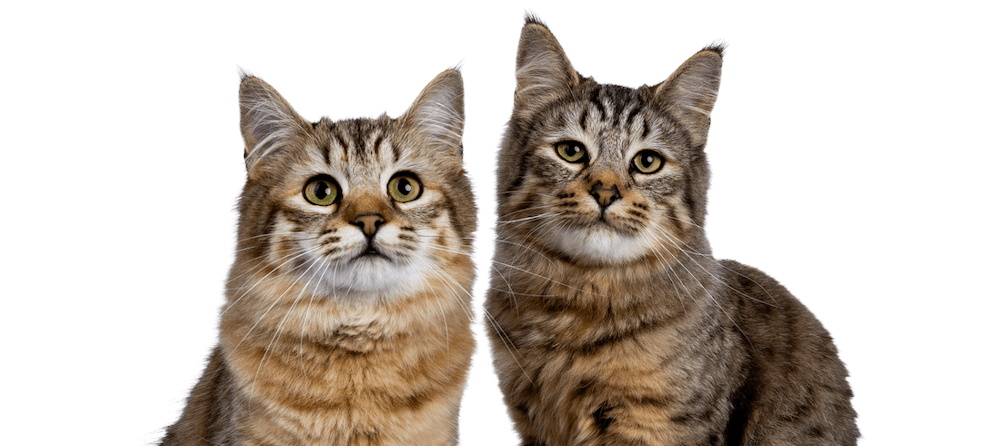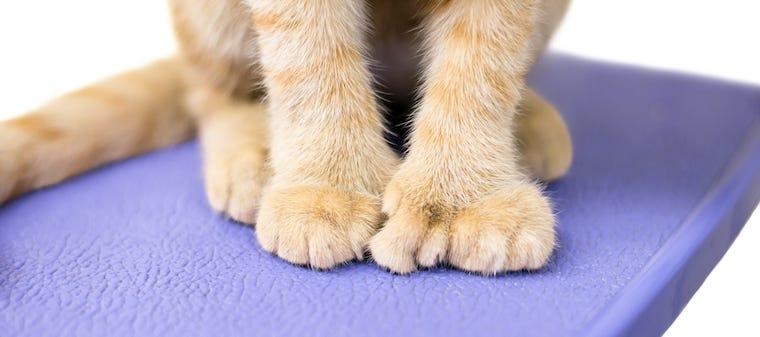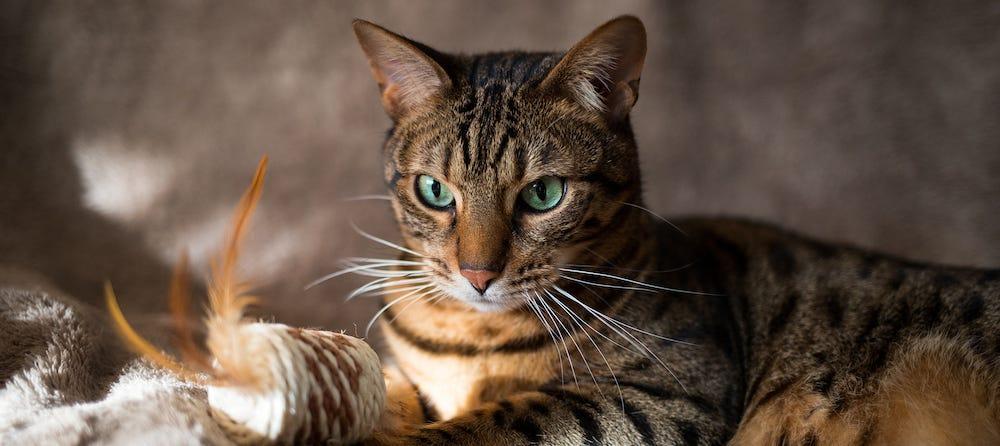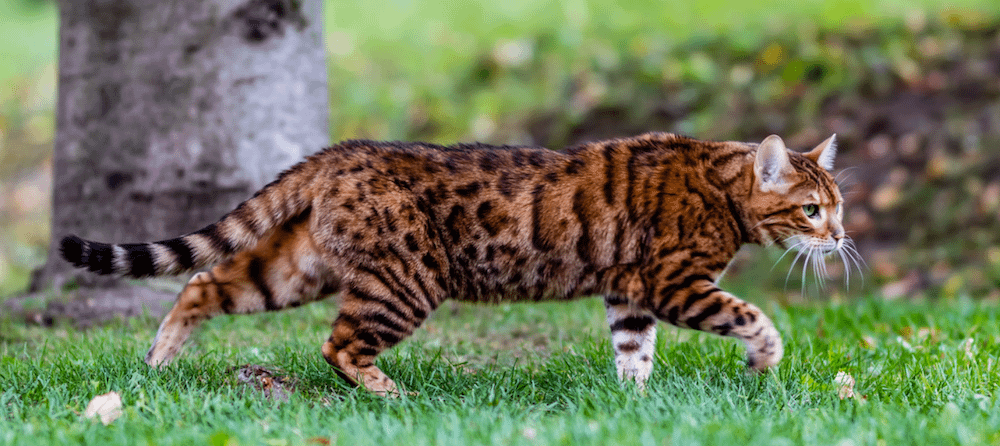Have you ever wanted to take in a wild bobcat and make it your own? Of course you know that, ethically, that just wouldn't be right. For many, it’s a dream to own a wildcat, but the reality is that it is simply irresponsible and likely dangerous to do so. Not only that, it’s not legal to keep big cats as pets since these animals need care beyond what a person can provide; domestic living situations don’t make them happy or healthy.
But what if you could find a cat that resembled a wild bobcat but was happy to live with you? That’s what having a Pixie-bob cat is like!
The Pixie-bob is fully domesticated, amazingly sweet, and friendly to boot. With a Pixie-bob, you get all of the advantages of having a unique and wild-looking cat that truly wants to cuddle and play all day long. Pixie-bobs are a wonderful cat breed that gets along well in families with multiple people and pets for them to accompany.
Read more about the Pixie-bob cat and why they make for such a great cat.
| Pixie-bob cat | ...at a glance |
|---|---|
| Personality | Playful, devoted, easygoing |
| Life expectancy | 10-15 years |
| Weight | 8-17 lbs |
| Coat & colors | Short or long; brown tabby |
| Energy level | Medium |
| Affection level | High |
| Friendliness | High |
| Shedding level | Medium to High |
| Required grooming | Medium |
Overview of the Pixie-bob cat
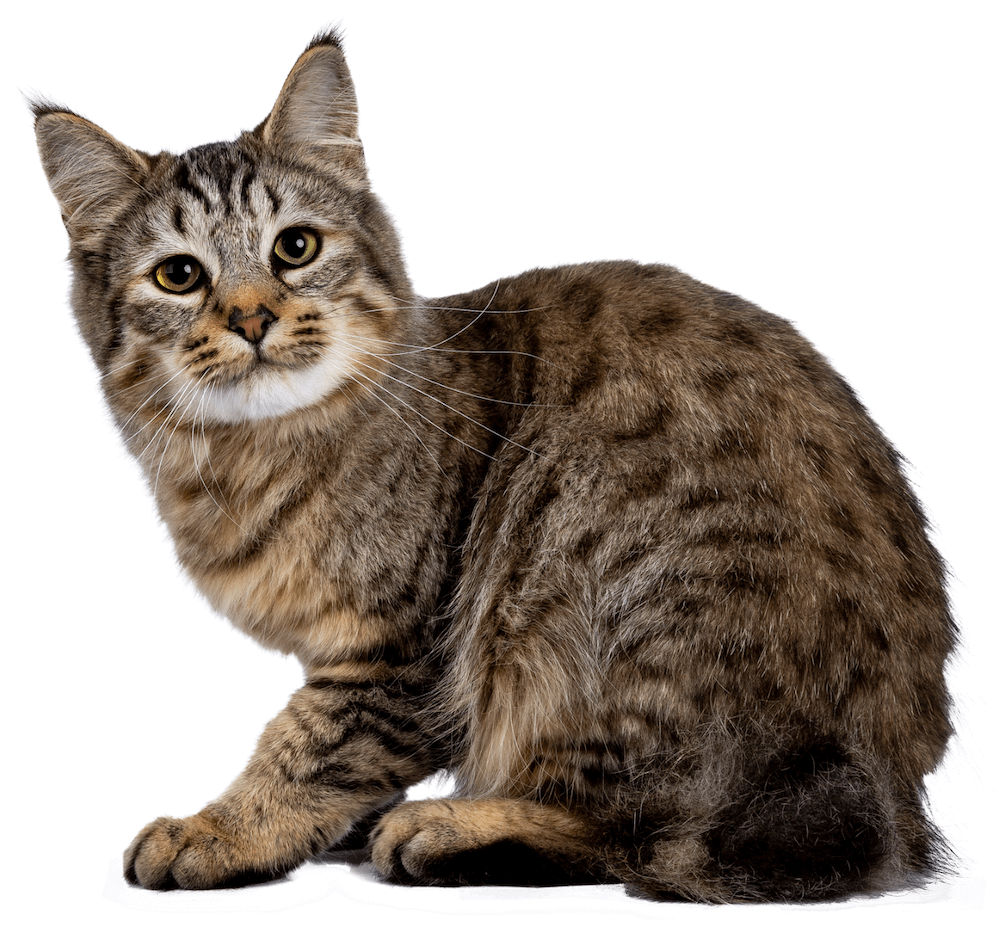
Pixie-bob cats are medium- to large-sized cats that closely resemble the North American bobcat. They are extremely sturdy and muscular, with an athletic build and outgoing demeanor. This cat loves to play and can be quite active.
They thrive on plenty of attention and sometimes are described as being dog-like in their behavior. Pixie-bobs are also recognized for their short bobbed tails, another feature common among wild bobcats.
Weight
Pixie-bob cats might appear small next to a wild bobcat, but when compared to other domesticated cats, they are quite large. Pixie-bobs weigh between 8 and 17 pounds, but most end up on the heavier side of that range.
Female Pixie-bobs are usually lighter and smaller than male Pixie-bobs, but there are many factors that can play into their size, including activity levels, nutrition, and health.
Length
Despite not having much of a tail, the Pixie-bob is a long cat. They can measure up to 24 inches in length, meaning that even with a bobtail they are longer than most domesticated cats.
Coat
Pixie-bobs can have short or long coats. When they have long coats, they shed quite a bit and require a more intense grooming schedule than some other breeds of cats.
As for their colors, the Pixie-bob can come in all shades of brown and will have a tabby pattern that includes small- to medium-sized spots on their underbelly. They usually have golden-brown or green eyes.
Life expectancy
When properly cared for, Pixie-bobs typically live between 10 and 15 years. They are a relatively healthy breed that will thrive when given enough exercise and mental stimulation. Regular veterinarian check-ups are another easy way to keep your Pixie-bob healthy and happy!
History of the Pixie-bob cat
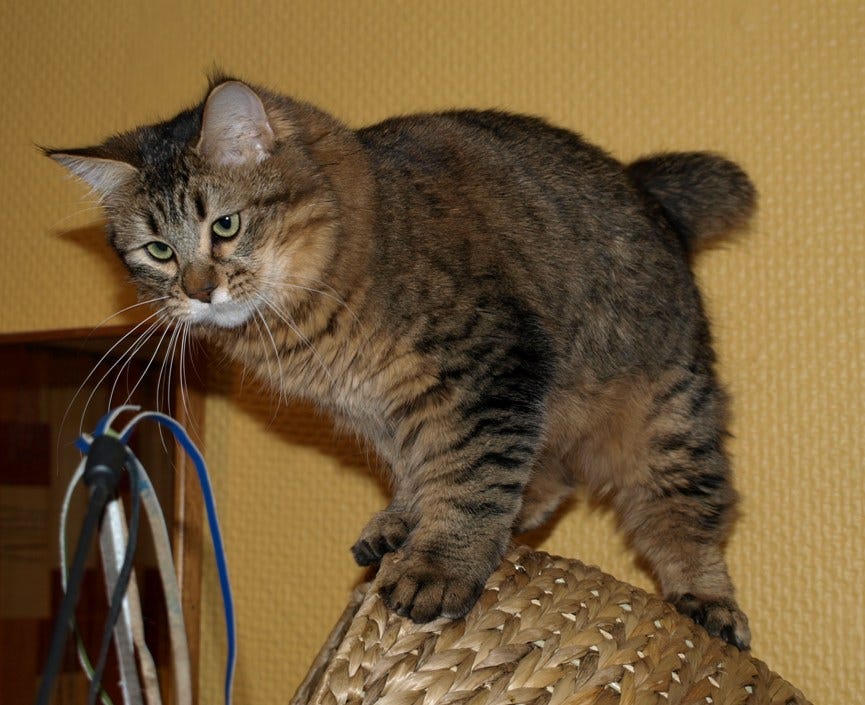
The origins of the Pixie-bob are somewhat of a mystery. There is no actual DNA evidence that can prove that they are descendants of the North American bobcat, even though the resemblance is uncanny. What DNA testing found is that the Pixie-bob is a wholly domesticated cat that only closely resembles a wild cat.
In the 1980s, Carol Ann Brewer rescued a short-tailed male cat that had extra toes (polydactyly) and was exceptionally large. This cat was rumored to be the product of a domestic cat and bobcat bred together, but there was nothing to prove this theory. The cat resembled a bobcat, so the rumor was easy to accept.
This large cat mated with one of Brewer’s neighbor’s brown tabby cats, and within the litter, other bobtailed, spotted kittens were born. She adopted one of the female kittens from this litter and named her Pixie, which became the namesake of the breed.
Brewer kept breeding cats that had bobbed tails and spots covering their body to establish the breed she named Pixie-bob. Despite the resemblance, no captive American bobcats were ever used in the breeding process, so the Pixie-bobs we know and love today don’t have wildcat blood running through them. This is evident in their friendly demeanor and personality.
Characteristics of the Pixie-bob
Upon first glance, the Pixie-bob does resemble the wild bobcat quite closely. They have bobbed tails, tabby patterning, and lynx-tipped ears, which is similar to the wildcat’s appearance. Pixie-bobs are muscular and athletic in their build, making them strong and powerful cats.
They have large heads and ears, and often appear to have mutton chops on their faces because of the sprouts of fur that come off them. They can have tufted ears, and they are known to be really, really furry—meaning that they may shed more than other cats do.
When it comes to the length of their tail, anything between 2 and 4 inches long is accepted. Some Pixie-bobs have full-length tails, although it is less common. They are also one of the only domestic cat breeds where having extra toes (up to seven on one paw) is acceptable.
Personality and behavior
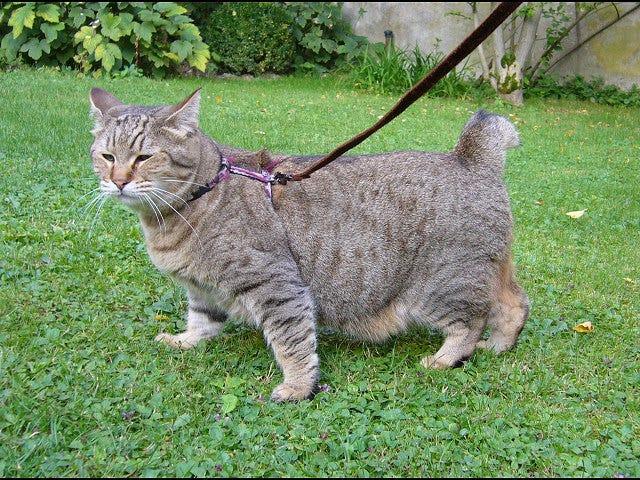
Despite their wild looks, the Pixie-bob is fully domesticated, and that is reflected in their behavior. These cats are sweet-tempered and extremely loving. They love to spend time with their humans and get along well with both children and other pets.
Pixie-bobs are regarded as dog-like and will make best friends with a dog or other cats in your home. They are tolerant creatures, but introducing them to your children should be done in a way that is respectful to the animal.
While playful and loving, these cats also know when to relax. They like to curl up on your lap and take a nap just as much as they like to run around the house. Though they can have bursts of energy, you might end up with a more laid-back cat, so don’t expect them to be jumping off the walls.
Having toys and places for your Pixie-bob to climb and explore can help expel their energy. Pixie-bobs are quite adaptable, making them typically well-suited for different living situations and traveling. You might even be able to convince your Pixie-bob to go on a leashed walk with you, which will definitely have your neighbors doing double-takes.
Caring for a Pixie-bob cat
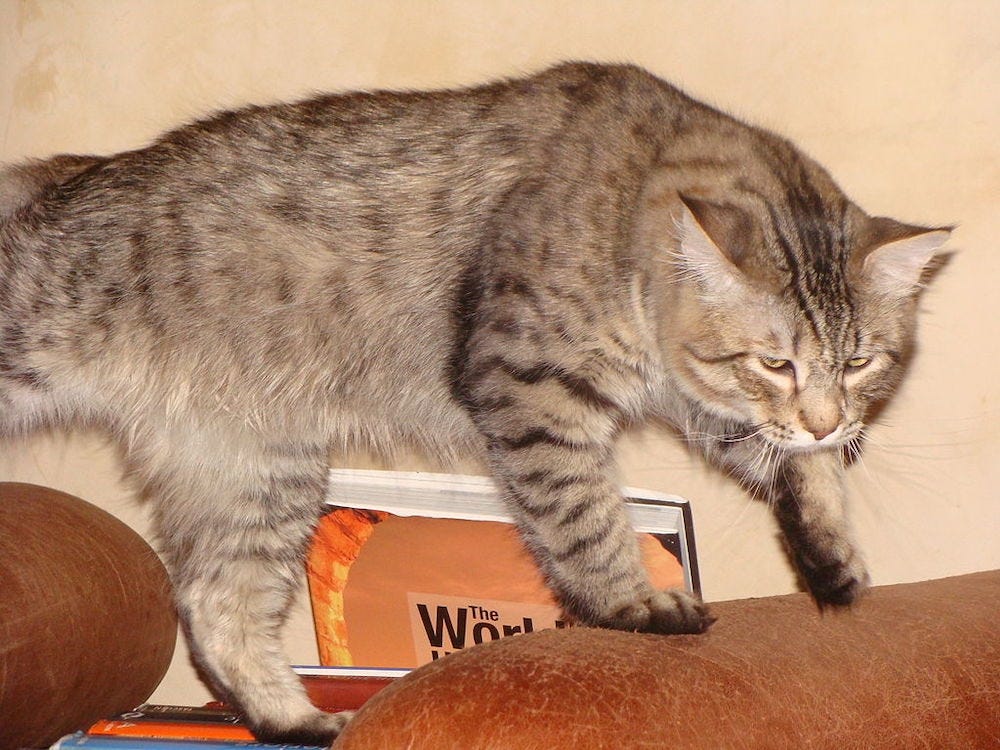
Pixie-bobs are fairly easy to care for. While they may have higher grooming requirements than some other breeds, they are adaptable and easygoing, making them the perfect pet for a laid-back household.
Investing in cat trees for your Pixie-bob to climb on and interactive toys that will fulfill your cat’s hunting needs is a great way to keep your cat engaged and content.
The main thing you should be able to do for your Pixie-bob is to provide them with love and affection, as they seek it from their humans. Giving your Pixie-bob a home that involves them and encourages them in everyday matters will make for a very happy kitty.
Grooming
Pixie-bobs have lush, dense coats that may result in a lot of shedding. With a long-haired Pixiebob, you will want to brush them at least three times a week. Ideally, you would spend 15 minutes every day combing through their coats to help keep them in great condition. Short-haired Pixie-bobs likely require less grooming time.
It’s important to trim their nails at least once a month. Additionally, brushing their teeth can help avoid periodontal disease. Your Pixie-bob should have a clean bathroom area, which is much easier done when you invest in a self-cleaning litter box. Only a clean litter box can be a useful litter box.
Health-related issues
While Pixie-bob cats are generally healthy, there are some potential issues to be aware of. Problems common in the cat world also apply to the Pixie-bob, including hypertrophic cardiomyopathy and kidney issues.
This breed is more likely to gain weight, so you should keep an eye out on how much you are feeding them and if they are getting enough exercise. You might have to engage them in play to ensure they exercise enough. Weight gain might cause stress on their limbs and influence more issues related to the heart.
Taking home a Pixie-bob
The Pixie-bob is a great cat to have in your life. If you are looking for a best friend, you can find one in this breed. They are outgoing and friendly, meaning that they will be part of all of your group gatherings. Don’t be surprised if your friends and family are in awe of your wild-looking cat!
Sources:
- Multiple Mutant T Alleles Cause Haploinsufficiency Of Brachyury And Short Tails In Manx Cats | NCBI
- Hypertrophic Cardiomyopathy | Cornell University College of Veterinary Medicine
- U.S. House passes bill to prohibit keeping big cats as pets and for public contact | US Humane Society
Photo credits:
- © Donna Cox / Wikimedia Commons / CC-BY-3.0
- © Gertrud Keazor / Wikimedia Commons / CC-BY-3.0
- © Nathalie Bent / Wikimedia Commons / CC-BY-3.0
